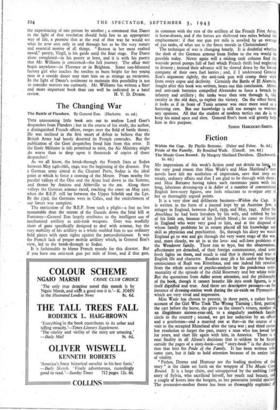The Changing War
The Battle of Flanders. By General Eon. (Hachette. 2S. od.) Tins unassuming little book sets out to analyse Lord Gort's despatches from Flanders ; but in the course of his study, the author, a distinguished French officer, ranges over the field of battle theory. He was inclined in the first smart of defeat to believe that the British Army had basely deserted its French comrades. But the publication of the Gort despatches freed him from this error. If the Ecole Militaire is stilt permitted to exist, the Air Ministry might do worse than to drop upon it thousands of copies of those despatches!
As we all know, the break-through the French lines at Sedan between May 14th-16th, 1940, was the beginning of the disaster. For a German army aimed at the Channel Ports, Sedan is the ideal point at which to force a crossing of the Meuse. From nearby the parallel valleys of the Oise and the Aisne lead down to the Somme, and thence by Amiens and Abbeville to the sea. Along these valleys the German armour raced, reaching the coast on May arst, when the B.E.F. still lay between the Upper Scheldt and the Lys. By the 23rd, the Germans were in Calais, and the encirclement of our forces was complete.
The extrication of the B.E.F. from such a plight—a feat no less memorable than the retreat of the Guards down the fatal hill at Fontenoy—General Eon largely attributes to the intelligent use of mechanised artillery as anti-tank weapons. Gort was woefully short of guns specifically designed to deal with armour, but the very mobility of his artillery as a whole enabled him to use ordinary field pieces with open sights against the panzerdivisionen. It was the French lack of proper mobile artillery which, in General Eon's view, led to the break-through at Sedan.
It is fashionable to blame French morale for this disaster. But if you have one anti-tank gun per mile of front, and if that gun in common with the rest of the artillery of the French First Army, is horse-drawn, and if the horses are sheltered two miles behind the emplacement: if that one gun per mile is assailed by an average of 25o tanks, of what use is the finest morale in Christendom?
The technique of war is changing hourly. It is doubtful whether the dash of the 'German armour from Sedan to the sea would be possible today. Never again will a raiding tank column find the wayside petrol pumps full of fuel which French thrift had neglected to destroy ; instead their advance will be slowed down by the forced company of their own fuel lorriesand, if I understand General Eon's argument rightly, the anti-tank gun will cramp their style from every copse and declivity. Certainly the Battle of El Alamein, fought after this book was written, bears out this conclusion_ Mines and anti-tank batteries compelled Alexander. to force a breach by infantry and artillery ; the tanks were then sent through it, like cavalry in the old days, to exploit the victory. On the other hand, it looks as if in front of Tunis armour was once more used as a battering ram. But our knowledge is still too meagre to warrant any opinions. All that the student of modern tactics can do is to keep his mind open and alert. General Eon's book will greatly help him in this purpose.
SIMON HARC.OURT-SMITH.


























 Previous page
Previous page